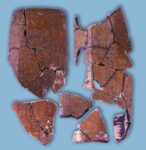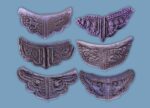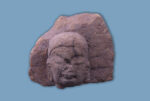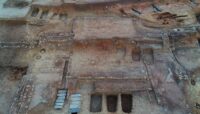 Archaeologists have discovered the remains of a large temple from the State of Nanzhao (738-902) in Dali City, in southwest China’s Yunnan Province. The foundations of 14 buildings, 63 stone walls, 23 ditches and three staircases have been unearthed, More than 40 tons of tiles — roof tiles, eaves, cylinder tiles — that once adorned the temple buildings have been recovered, and more 8,000 pottery artifacts including vessels and inscribed tiles.
Archaeologists have discovered the remains of a large temple from the State of Nanzhao (738-902) in Dali City, in southwest China’s Yunnan Province. The foundations of 14 buildings, 63 stone walls, 23 ditches and three staircases have been unearthed, More than 40 tons of tiles — roof tiles, eaves, cylinder tiles — that once adorned the temple buildings have been recovered, and more 8,000 pottery artifacts including vessels and inscribed tiles.
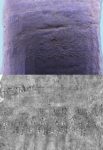 One of the inscribed tiles was discovered in the foundation of the main building under its Great Hall.
One of the inscribed tiles was discovered in the foundation of the main building under its Great Hall.
In the complex, the researchers discovered a tile inscribed with the characters “Buddha sarira enshrined by the government,” which indicates that the Buddhist relics of Nanzhao’s royal court are likely to have been enshrined and worshiped inside the temple. The complex is therefore believed to be a major religious site of Taihe, said the institute.
“Sarira” is a general term with a number of meanings, but is generally used to describe the bodily remains after a Buddhist cremation. The remains of Buddhist masters were often said to contain crystalline beads or pearl-like objects.
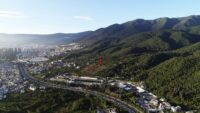 Nanzhao was a vassal state of the Tang Dynasty that at its apex covered parts of modern-day Laos, Myanmar and Vietnam. Its capital was Taihe, today Taihe village a few miles south of Dali City. It is sometimes referred to as a slave state, because there appears to have been a caste system that had at least two factions — administrators and soldiers — and slaveowners were ranked among the wealthy elite even if they were cash-poor. Holdings of gold, livestock and enslaved people were determiners of societal rank, so much so that personal names often boasted of slave ownership.
Nanzhao was a vassal state of the Tang Dynasty that at its apex covered parts of modern-day Laos, Myanmar and Vietnam. Its capital was Taihe, today Taihe village a few miles south of Dali City. It is sometimes referred to as a slave state, because there appears to have been a caste system that had at least two factions — administrators and soldiers — and slaveowners were ranked among the wealthy elite even if they were cash-poor. Holdings of gold, livestock and enslaved people were determiners of societal rank, so much so that personal names often boasted of slave ownership.
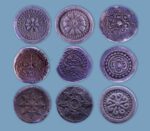 The site has been surveyed before and archaeological remains have been found going back to the Warring States period (475–221 B.C.) The temple remains were unearthed last year. The recent dig also revealed a ceramic production area on the eastern side of the complex. Two kilns were found along with the remains of defective pottery and 9,200 kiln tools including, nails, gaskets and moulages.
The site has been surveyed before and archaeological remains have been found going back to the Warring States period (475–221 B.C.) The temple remains were unearthed last year. The recent dig also revealed a ceramic production area on the eastern side of the complex. Two kilns were found along with the remains of defective pottery and 9,200 kiln tools including, nails, gaskets and moulages.
The excavation helps reveal the layout characteristics of the temples built during the Nanzhao regime, the production status of the kilns and funeral customs of the royal family, according to the institute.
